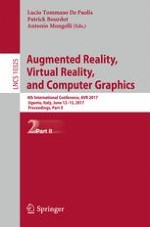2017 | OriginalPaper | Buchkapitel
Natural User Interface to Assess Social Skills in Autistic Population
verfasst von : Claudia Faita, Raffaello Brondi, Camilla Tanca, Marcello Carrozzino, Massimo Bergamasco
Erschienen in: Augmented Reality, Virtual Reality, and Computer Graphics
Aktivieren Sie unsere intelligente Suche, um passende Fachinhalte oder Patente zu finden.
Wählen Sie Textabschnitte aus um mit Künstlicher Intelligenz passenden Patente zu finden. powered by
Markieren Sie Textabschnitte, um KI-gestützt weitere passende Inhalte zu finden. powered by
